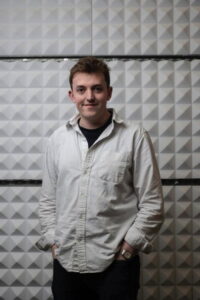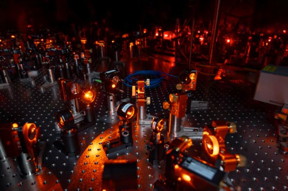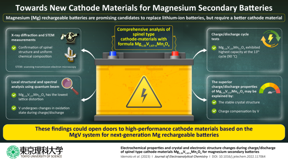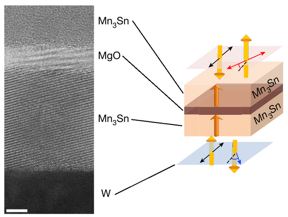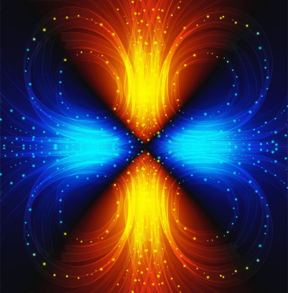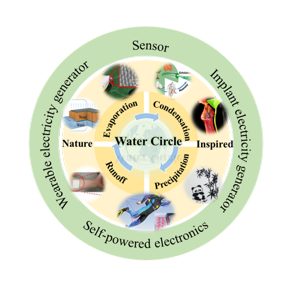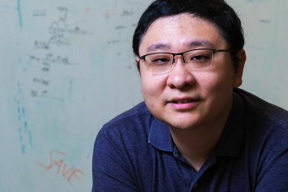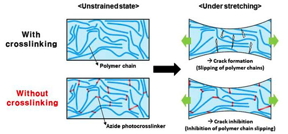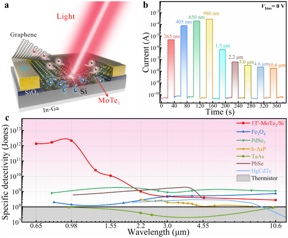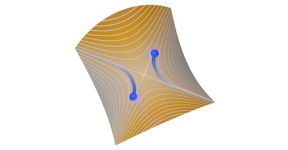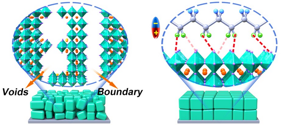Home > Press > Three-pronged approach discerns qualities of quantum spin liquids
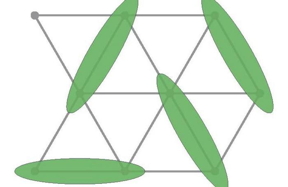 |
| An illustration of the lattice examined by Phil Anderson in the early ‘70s. Shown as green ellipses, pairs of quantum particles fluctuated among multiple combinations to produce a spin liquid state. CREDIT Allen Scheie/Los Alamos National Laboratory, U.S. Dept. of Energy |
Abstract:
In 1973, physicist Phil Anderson hypothesized that the quantum spin liquid, or QSL, state existed on some triangular lattices, but he lacked the tools to delve deeper. Fifty years later, a team led by researchers associated with the Quantum Science Center headquartered at the Department of Energy’s Oak Ridge National Laboratory has confirmed the presence of QSL behavior in a new material with this structure, KYbSe2.
Three-pronged approach discerns qualities of quantum spin liquids
Oak Ridge, TN | Posted on November 17th, 2023QSLs — an unusual state of matter controlled by interactions among entangled, or intrinsically linked, magnetic atoms called spins — excel at stabilizing quantum mechanical activity in KYbSe2 and other delafossites. These materials are prized for their layered triangular lattices and promising properties that could contribute to the construction of high-quality superconductors and quantum computing components.
The paper, published in Nature Physics, features researchers from ORNL; Lawrence Berkeley National Laboratory; Los Alamos National Laboratory; SLAC National Accelerator Laboratory; the University of Tennessee, Knoxville; the University of Missouri; the University of Minnesota; Stanford University; and the Rosario Physics Institute.
“Researchers have studied the triangular lattice of various materials in search of QSL behavior,” said QSC member and lead author Allen Scheie, a staff scientist at Los Alamos. “One advantage of this one is that we can swap out atoms easily to modify the material’s properties without altering its structure, and this makes it pretty ideal from a scientific perspective.”
Using a combination of theoretical, experimental and computational techniques, the team observed multiple hallmarks of QSLs: quantum entanglement, exotic quasiparticles and the right balance of exchange interactions, which control how a spin influences its neighbors. Although efforts to identify these features have historically been hindered by the limitations of physical experiments, modern neutron scattering instruments can produce accurate measurements of complex materials at the atomic level.
By examining KYbSe2’s spin dynamics with the Cold Neutron Chopper Spectrometer at ORNL’s Spallation Neutron Source — a DOE Office of Science user facility — and comparing the results to trusted theoretical models, the researchers found evidence that the material was close to the quantum critical point at which QSL characteristics thrive. They then analyzed its single-ion magnetic state with SNS’s Wide-Angular-Range Chopper Spectrometer.
The witnesses in question are the one-tangle, two-tangle and quantum Fisher information, which has played a key role in previous QSC research focused on examining a 1D spin chain, or a single line of spins within a material. KYbSe2 is a 2D system, a quality that made these endeavors more complex.
“We are taking a co-design approach, which is hardwired into the QSC,” said Alan Tennant, a professor of physics and materials science and engineering at UTK who leads a quantum magnets project for the QSC. “Theorists within the center are calculating things they haven’t been able to calculate before, and this overlap between theory and experiment enabled this breakthrough in QSL research.”
This study aligns with the QSC’s priorities, which include connecting fundamental research to quantum electronics, quantum magnets and other current and future quantum devices.
“Gaining a better understanding of QSLs is really significant for the development of next-generation technologies,” Tennant said. “This field is still in the fundamental research state, but we can now identify which materials we can modify to potentially make small-scale devices from scratch.”
Although KYbSe2 is not a true QSL, the fact that about 85% of the magnetism fluctuates at low temperature means that it has the potential to become one. The researchers anticipate that slight alternations to its structure or exposure to external pressure could potentially help it reach 100%.
QSC experimentalists and computational scientists are planning parallel studies and simulations focused on delafossite materials, but the researchers’ findings established an unprecedented protocol that can also be applied to study other systems. By streamlining evidence-based evaluations of QSL candidates, they aim to accelerate the search for genuine QSLs.
“The important thing about this material is that we’ve found a way to orient ourselves on the map so to speak and show what we’ve gotten right,” Scheie said. “We’re pretty sure there’s a full QSL somewhere within this chemical space, and now we know how to find it.”
This work received support from DOE, the QSC, the National Council for Scientific and Technical Research and the Simons Foundation.
####
About DOE/Oak Ridge National Laboratory
The QSC, a DOE National Quantum Information Science Research Center led by ORNL, performs cutting-edge research at national laboratories, universities and industry partners to overcome key roadblocks in quantum state resilience, controllability and ultimately the scalability of quantum technologies. QSC researchers are designing materials that enable topological quantum computing; implementing new quantum sensors to characterize topological states and detect dark matter; and designing quantum algorithms and simulations to provide a greater understanding of quantum materials, chemistry and quantum field theories. These innovations enable the QSC to accelerate information processing, explore the previously unmeasurable and better predict quantum performance across technologies. For more information, visit https://qscience.org .
UT-Battelle manages ORNL for DOE’s Office of Science, the single largest supporter of basic research in the physical sciences in the United States. DOE’s Office of Science is working to address some of the most pressing challenges of our time. For more information, visit https://energy.gov/science . — Elizabeth Rosenthal
For more information, please click here
Contacts:
Elizabeth Rosenthal
DOE/Oak Ridge National Laboratory
Office: 865-241-6579
Copyright © DOE/Oak Ridge National Laboratory
If you have a comment, please Contact us.Issuers of news releases, not 7th Wave, Inc. or Nanotechnology Now, are solely responsible for the accuracy of the content.
| Related Links |
| Related News Press |
News and information
![]() Inverted perovskite solar cell breaks 25% efficiency record: Researchers improve cell efficiency using a combination of molecules to address different November 17th, 2023
Inverted perovskite solar cell breaks 25% efficiency record: Researchers improve cell efficiency using a combination of molecules to address different November 17th, 2023
![]() Night-time radiative warming using the atmosphere November 17th, 2023
Night-time radiative warming using the atmosphere November 17th, 2023
![]() A new kind of magnetism November 17th, 2023
A new kind of magnetism November 17th, 2023
Quantum Physics
![]() The USTC realizes In situ electron paramagnetic resonance spectroscopy using single nanodiamond sensors November 3rd, 2023
The USTC realizes In situ electron paramagnetic resonance spectroscopy using single nanodiamond sensors November 3rd, 2023
![]() What a “2D” quantum superfluid feels like to the touch November 3rd, 2023
What a “2D” quantum superfluid feels like to the touch November 3rd, 2023
Quantum chemistry
Magnetism/Magnons
![]() Study on Magnetic Force Microscopy wins 2023 Advances in Magnetism Award: Analysis of finite size effects reveals significant consequences for density measurements November 3rd, 2023
Study on Magnetic Force Microscopy wins 2023 Advances in Magnetism Award: Analysis of finite size effects reveals significant consequences for density measurements November 3rd, 2023
Laboratories
![]() A non-covalent bonding experience: Scientists discover new structures for unique hybrid materials by altering their chemical bonds July 21st, 2023
A non-covalent bonding experience: Scientists discover new structures for unique hybrid materials by altering their chemical bonds July 21st, 2023
Govt.-Legislation/Regulation/Funding/Policy
![]() Inverted perovskite solar cell breaks 25% efficiency record: Researchers improve cell efficiency using a combination of molecules to address different November 17th, 2023
Inverted perovskite solar cell breaks 25% efficiency record: Researchers improve cell efficiency using a combination of molecules to address different November 17th, 2023
![]() Nanoparticle quasicrystal constructed with DNA: The breakthrough opens the way for designing and building more complex structures November 3rd, 2023
Nanoparticle quasicrystal constructed with DNA: The breakthrough opens the way for designing and building more complex structures November 3rd, 2023
Possible Futures
![]() Shedding light on unique conduction mechanisms in a new type of perovskite oxide November 17th, 2023
Shedding light on unique conduction mechanisms in a new type of perovskite oxide November 17th, 2023
![]() Silver nanoparticles: guaranteeing antimicrobial safe-tea November 17th, 2023
Silver nanoparticles: guaranteeing antimicrobial safe-tea November 17th, 2023
![]() Inverted perovskite solar cell breaks 25% efficiency record: Researchers improve cell efficiency using a combination of molecules to address different November 17th, 2023
Inverted perovskite solar cell breaks 25% efficiency record: Researchers improve cell efficiency using a combination of molecules to address different November 17th, 2023
![]() Night-time radiative warming using the atmosphere November 17th, 2023
Night-time radiative warming using the atmosphere November 17th, 2023
Discoveries
![]() Inverted perovskite solar cell breaks 25% efficiency record: Researchers improve cell efficiency using a combination of molecules to address different November 17th, 2023
Inverted perovskite solar cell breaks 25% efficiency record: Researchers improve cell efficiency using a combination of molecules to address different November 17th, 2023
![]() Night-time radiative warming using the atmosphere November 17th, 2023
Night-time radiative warming using the atmosphere November 17th, 2023
![]() A new kind of magnetism November 17th, 2023
A new kind of magnetism November 17th, 2023
Announcements
![]() Inverted perovskite solar cell breaks 25% efficiency record: Researchers improve cell efficiency using a combination of molecules to address different November 17th, 2023
Inverted perovskite solar cell breaks 25% efficiency record: Researchers improve cell efficiency using a combination of molecules to address different November 17th, 2023
![]() Night-time radiative warming using the atmosphere November 17th, 2023
Night-time radiative warming using the atmosphere November 17th, 2023
![]() A new kind of magnetism November 17th, 2023
A new kind of magnetism November 17th, 2023
Interviews/Book Reviews/Essays/Reports/Podcasts/Journals/White papers/Posters
![]() Inverted perovskite solar cell breaks 25% efficiency record: Researchers improve cell efficiency using a combination of molecules to address different November 17th, 2023
Inverted perovskite solar cell breaks 25% efficiency record: Researchers improve cell efficiency using a combination of molecules to address different November 17th, 2023
![]() Night-time radiative warming using the atmosphere November 17th, 2023
Night-time radiative warming using the atmosphere November 17th, 2023
![]() A new kind of magnetism November 17th, 2023
A new kind of magnetism November 17th, 2023
Grants/Sponsored Research/Awards/Scholarships/Gifts/Contests/Honors/Records
![]() Study on Magnetic Force Microscopy wins 2023 Advances in Magnetism Award: Analysis of finite size effects reveals significant consequences for density measurements November 3rd, 2023
Study on Magnetic Force Microscopy wins 2023 Advances in Magnetism Award: Analysis of finite size effects reveals significant consequences for density measurements November 3rd, 2023
![]() Training quantum computers: physicists win prestigious IBM Award September 8th, 2023
Training quantum computers: physicists win prestigious IBM Award September 8th, 2023
![]() The present and future of computing get a boost from new research July 21st, 2023
The present and future of computing get a boost from new research July 21st, 2023
- SEO Powered Content & PR Distribution. Get Amplified Today.
- PlatoData.Network Vertical Generative Ai. Empower Yourself. Access Here.
- PlatoAiStream. Web3 Intelligence. Knowledge Amplified. Access Here.
- PlatoESG. Carbon, CleanTech, Energy, Environment, Solar, Waste Management. Access Here.
- PlatoHealth. Biotech and Clinical Trials Intelligence. Access Here.
- Source: http://www.nanotech-now.com/news.cgi?story_id=57422
- :has
- :is
- :not
- $UP
- 10
- 17th
- 1973
- 2023
- 21st
- 28
- 2D
- 3rd
- 7th
- 8th
- a
- Able
- About
- accelerate
- accelerator
- accuracy
- accurate
- acoustic
- across
- activity
- address
- advances
- ADvantage
- aim
- Alan
- algorithms
- Aligns
- allen
- also
- Although
- among
- an
- analysis
- analyzed
- and
- anderson
- anticipate
- applied
- approach
- ARE
- around
- AS
- associated
- At
- atom
- atomic
- author
- award
- Balance
- based
- basic
- batteries
- BE
- become
- been
- before
- behavior
- Berkeley
- Better
- between
- boost
- breaks
- breakthrough
- Building
- burn
- but
- by
- calculate
- calculating
- called
- CAN
- candidates
- Catalyst
- cell
- Center
- CGI
- chain
- challenges
- characteristics
- characterize
- chemical
- chemistry
- click
- Close
- cold
- COM
- combination
- combinations
- comment
- comparing
- complex
- components
- computational
- computers
- computing
- conducted
- CONFIRMED
- Connecting
- Consequences
- construction
- content
- contribute
- control
- controlled
- Cost
- cost-effective
- could
- Council
- credit
- critical
- Current
- Cut
- cutting-edge
- dance
- Dark
- Dark matter
- Decline
- deeper
- del
- delve
- demonstrate
- density
- Department
- dept
- designing
- detect
- develop
- Development
- Devices
- discover
- discovered
- dna
- DOE
- dramatically
- dynamics
- Early
- easily
- effects
- efficiency
- efforts
- Electronic
- Electronics
- elizabeth
- enable
- enabled
- end
- endeavors
- energy
- Engineering
- Engines
- established
- Ether (ETH)
- evaluations
- evidence
- Examining
- Excel
- exchange
- Exotic
- expected
- experience
- experiment
- experimental
- experiments
- explore
- Exposure
- external
- Facility
- fact
- Features
- feels
- fibers
- field
- fifty years
- films
- Find
- findings
- fluctuated
- fluctuates
- focused
- For
- Force
- found
- Foundation
- from
- full
- fundamental
- future
- future of computing
- futuristic
- GAS
- genuine
- get
- gif
- greater
- Green
- greenhouse gas
- hallmarks
- Have
- he
- headquartered
- help
- helped
- High
- high-quality
- historically
- How
- How To
- http
- HTTPS
- Hybrid
- IBM
- ideal
- identify
- if
- implementing
- important
- improve
- in
- Inc.
- include
- industry
- industry partners
- information
- innovations
- Institute
- instruments
- interactions
- International
- international space station
- into
- intrinsically
- IT
- ITS
- jpg
- July
- Key
- Kind
- Know
- lab
- laboratories
- laboratory
- largest
- laser
- lasers
- later
- lawrence
- layered
- lead
- Leads
- Led
- lenses
- Level
- Life
- light
- like
- limitations
- Line
- linked
- links
- Liquid
- Long
- los
- Los Alamos National Laboratory
- Low
- made
- Magnetism
- Magnets
- make
- MAKES
- manages
- map
- material
- materials
- Matter
- means
- measurements
- mechanical
- mechanism
- mechanisms
- member
- methane
- Microscopy
- millions
- minnesota
- models
- Modern
- modify
- more
- most
- multiple
- nanotechnology
- National
- Natural
- Natural Gas
- Nature
- neighbors
- net
- New
- newly
- news
- next-generation
- nexus
- nicholas
- November
- now
- nuclear
- oak
- Oak Ridge National Laboratory
- observed
- of
- Office
- on
- ONE
- opens
- or
- ORNL
- Other
- our
- ourselves
- out
- Overcome
- pairs
- Paper
- Parallel
- partners
- pathway
- pave
- performance
- performs
- perspective
- PHIL
- PHP
- physical
- Physical Sciences
- Physics
- planning
- plato
- Plato Data Intelligence
- PlatoData
- played
- please
- Point
- Pollution
- Post
- posted
- potent
- potential
- potentially
- predict
- presence
- present
- press
- Press Release
- pressing
- pressure
- prestigious
- pretty
- previous
- previously
- prized
- probe
- processing
- produce
- Professor
- project
- promising
- properties
- protocol
- provide
- published
- qualities
- quality
- Quantum
- quantum algorithms
- quantum computers
- quantum computing
- quantum entanglement
- quantum information
- quantum materials
- quantum particles
- Quantum Science Center
- Quantum sensors
- question
- rapid
- reach
- reaction
- really
- received
- record
- release
- Releases
- remove
- research
- researchers
- resilience
- resonance
- responsible
- Results
- return
- reveal
- Revealed
- Reveals
- right
- roadblocks
- Role
- Room
- s
- Said
- Save
- Scalability
- Science
- SCIENCES
- scientific
- Scientist
- scientists
- scratch
- Search
- sensors
- September
- setup
- Share
- show
- shown
- significant
- single
- Size
- So
- solar
- solely
- some
- somewhere
- Source
- Space
- space station
- speak
- Spectroscopy
- speed
- Spin
- spins
- Staff
- stanford
- Stanford university
- start
- State
- State of matter
- States
- station
- Still
- streamlining
- structure
- structures
- studied
- studies
- Study
- submit
- support
- supporter
- sure
- swap
- system
- Systems
- taking
- team
- Technical
- technique
- techniques
- Technologies
- tennessee
- that
- The
- the world
- their
- then
- theoretical
- theory
- These
- they
- thing
- things
- this
- Thrive
- time
- to
- tools
- topological quantum
- true
- trusted
- type
- u.s.
- Ultimately
- understanding
- unique
- United
- United States
- Universities
- university
- University of Minnesota
- unknown
- unprecedented
- unusual
- us
- User
- using
- USTC
- various
- Visit
- was
- Wave
- Way..
- we
- What
- which
- WHO
- will
- win
- Wins
- with
- within
- without
- Work
- working
- world
- Yahoo
- years
- you
- zephyrnet











